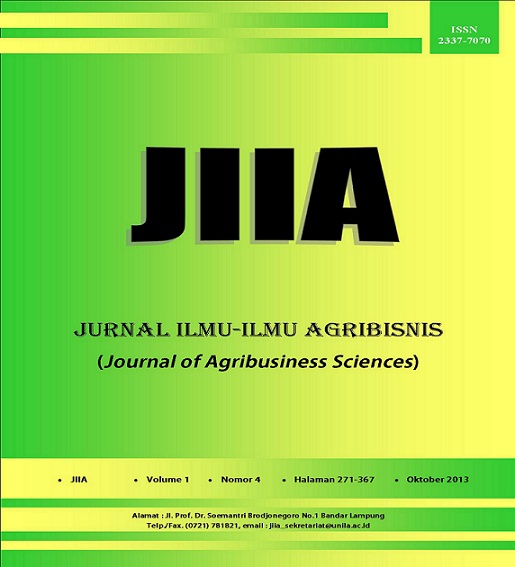NILAI TAMBAH DAN KELAYAKAN USAHA SKALA KECIL DAN SKALA MENENGAH PENGOLAHAN LIMBAH PADAT UBI KAYU (ONGGOK) DI KECAMATAN PEKALONGAN KABUPATEN LAMPUNG TIMUR
DOI:
https://doi.org/10.23960/jiia.v1i4.704 Abstract View: 1058
Abstract View: 1058
Abstract
The purposes of this research were to determine value addedand analyze the feasibility of cassava solid waste (“onggok”) processing business.This research was conducted in Pekalongan District,East Lampung Regency in which in two businesses of medium-scale processor and small-scale processor were chosen purposely based on the criteria of MSME (Micro, Small and Medium Enterprises).The primary data was analyzed by calculating the value-added, NPV, IRR, gross B/C ratio, net B/C ratio, and payback period. In addition, the sensitivity analysis was done based on the possibility of cost increase, price reduction, and production decrease.The results showed that the small-scale processorgave larger value-addedthan the medium-scale. Based on market, social, and environmental as well as financial aspects, cassava solid waste processors were profitable and feasible to be developed. These businesses were sensitive to the increase in production cost and the decrease in production.Key words : added value, cassava solid waste, feasibility of bussiness
Downloads
Downloads
Published
How to Cite
Issue
Section
License
Authors who publish with this journal agree to the following terms:
Authors retain copyright and grant the journal right of first publication with the work simultaneously licensed under a Creative Commons Attribution License that allows others to share the work with an acknowledgement of the work's authorship and initial publication in this journal.
Authors are able to enter into separate, additional contractual arrangements for the non-exclusive distribution of the journal's published version of the work (e.g., post it to an institutional repository or publish it in a book), with an acknowledgement of its initial publication in this journal.
Authors are permitted and encouraged to post their work online (e.g., in institutional repositories or on their website) prior to and during the submission process, as it can lead to productive exchanges, as well as earlier and greater citation of published work (See The Effect of Open Access).














